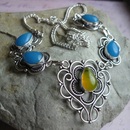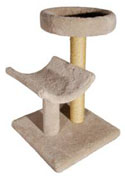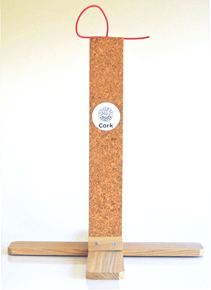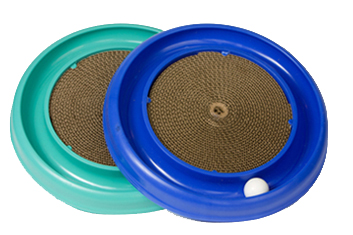Scratching: Doing what comes naturally
With nothing better to use, scratching a couch or a chair is natural for a cat - even a cat who has no claws. Why do cats scratch? To groom their claws, of course. But they also scratch to stretch the muscles in their backs and to mark their territory, both visually and with their scent. How do you keep your cat from using your furniture to do what comes naturally? Just offer an alternative.
|
---Provide a variety of surfaces for your cat to scratch. Some suggestions: scratching posts covered with sisal, burlap or carpeting; corrugated cardboard scratchers; carpet remnants; wood or logs; and door mats.
---Choose scratching posts that are stable and tall enough for your cat to have a good stretch. The cat should be able to stretch up to full length and arch her back. Entice her to the post by sprinkling catnip on the base and hanging a toy at the top. ---Invest in cat furniture, or build it yourself. For instance, a six-foot wooden ladder covered with sisal makes a great cat tree. Cat furniture provides opportunities for scratching, climbing and napping all in one place! ---Keep your cat's nails trimmed. Ask your vet to show you how. |
About Declawing |
if your cat is scratching the furniture
— Put a scratching post at the entrance to a room or against the furniture she's scratching. Lure her to the post by sprinkling catnip on the base and by playing with her near the post.
— Cover the furniture she's scratching with vinyl carpet runner bumpy side up; shelf paper, sticky side up; double-stick tape, bubble wrap or sheets. Cats find scratching smooth fabrics like sheets is not very satisfying.
— Rub the furniture with a scent cats dislike, like citrus.
— Use an electronic deterrent, like a ScatMat. The cat won’t like the tingling sensation underfoot.
--- Try Soft Paws, soft plastic caps that are glued onto the cat's claws.
— Cover the furniture she's scratching with vinyl carpet runner bumpy side up; shelf paper, sticky side up; double-stick tape, bubble wrap or sheets. Cats find scratching smooth fabrics like sheets is not very satisfying.
— Rub the furniture with a scent cats dislike, like citrus.
— Use an electronic deterrent, like a ScatMat. The cat won’t like the tingling sensation underfoot.
--- Try Soft Paws, soft plastic caps that are glued onto the cat's claws.
dig up some great scratchers
|
|

Please visit our online store. Beautiful handmade jewelry and cat-themed T-shirts are waiting for you there, and all the proceeds go to our cats!
|







